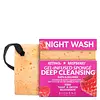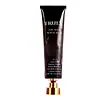What's inside
What's inside
 Key Ingredients
Key Ingredients

 Benefits
Benefits

 Concerns
Concerns

 Ingredients Side-by-side
Ingredients Side-by-side

Glycerin
HumectantSorbitol
HumectantStearic Acid
CleansingSucrose
HumectantVitis Vinifera Seed Oil
EmollientCocos Nucifera Oil
MaskingWater
Skin ConditioningSodium Cocoyl Isethionate
CleansingSodium Lauroyl Sarcosinate
CleansingMyristic Acid
CleansingSodium Hydroxide
BufferingButyrospermum Parkii Butter
Skin ConditioningParfum
MaskingPhenoxyethanol
PreservativeButylene Glycol
HumectantRubus Idaeus Fruit Extract
AstringentLecithin
EmollientCaprylic/Capric Triglyceride
MaskingRetinyl Palmitate
Skin ConditioningRetinol
Skin ConditioningBHT
AntioxidantTocopheryl Acetate
AntioxidantGlycerin, Sorbitol, Stearic Acid, Sucrose, Vitis Vinifera Seed Oil, Cocos Nucifera Oil, Water, Sodium Cocoyl Isethionate, Sodium Lauroyl Sarcosinate, Myristic Acid, Sodium Hydroxide, Butyrospermum Parkii Butter, Parfum, Phenoxyethanol, Butylene Glycol, Rubus Idaeus Fruit Extract, Lecithin, Caprylic/Capric Triglyceride, Retinyl Palmitate, Retinol, BHT, Tocopheryl Acetate
Sucrose
HumectantCocos Nucifera Oil
MaskingTocopherol
AntioxidantHelianthus Annuus Seed Oil
EmollientAzadirachta Indica Seed Oil
Skin ConditioningRosmarinus Officinalis Leaf Extract
AntimicrobialCharcoal Powder
AbrasiveGlycerin
HumectantSodium Cocoyl Isethionate
CleansingSorbitol
HumectantRosa Damascena Callus
AntimicrobialStearic Acid
CleansingMyristic Acid
CleansingDisodium Lauroamphodiacetate
CleansingLeuconostoc/Radish Root Ferment Filtrate
AntimicrobialAloe Barbadensis Leaf Juice
Skin ConditioningHamamelis Virginiana Water
AstringentAlcohol
AntimicrobialCarbomer
Emulsion StabilisingPhenoxyethanol
PreservativeTetrasodium Glutamate Diacetate
Persea Gratissima Fruit Butter
EmollientElaeis Guineensis Kernel Oil
EmollientChamomilla Recutita Flower Extract
MaskingCurcuma Longa Root Powder
Skin ConditioningSalicylic Acid
MaskingGold
Cosmetic ColorantParfum
MaskingSucrose, Cocos Nucifera Oil, Tocopherol, Helianthus Annuus Seed Oil, Azadirachta Indica Seed Oil, Rosmarinus Officinalis Leaf Extract, Charcoal Powder, Glycerin, Sodium Cocoyl Isethionate, Sorbitol, Rosa Damascena Callus, Stearic Acid, Myristic Acid, Disodium Lauroamphodiacetate, Leuconostoc/Radish Root Ferment Filtrate, Aloe Barbadensis Leaf Juice, Hamamelis Virginiana Water, Alcohol, Carbomer, Phenoxyethanol, Tetrasodium Glutamate Diacetate, Persea Gratissima Fruit Butter, Elaeis Guineensis Kernel Oil, Chamomilla Recutita Flower Extract, Curcuma Longa Root Powder, Salicylic Acid, Gold, Parfum
Ingredients Explained
These ingredients are found in both products.
Ingredients higher up in an ingredient list are typically present in a larger amount.
Cocos Nucifera Oil is obtained from the kernels of the coconut fruit. In other words, this is coconut oil.
Coconut Oil is rich in fatty acids with lauric acid making up the majority of these. It also contains linoleic acid. Due to this high fatty acid content, coconut oil helps trap moisture and soften skin.
Despite being antibacterial, coconut oil may not be great for acne-prone skin. It is comedogenic and may clog pores. This ingredient may not be safe for malassezia or fungal acne.
Note: Coconut Oil should not replace your sunscreen for UV protection. Studies show it only blocks about 20% of UV.
This oil is non-volatile and has a light scent.
The term 'fragrance' is not regulated in many countries. In many cases, it is up to the brand to define this term. For instance, many brands choose to label themselves as "fragrance-free" because they are not using synthetic fragrances. However, their products may still contain ingredients such as essential oils that are considered a fragrance.
Learn more about Cocos Nucifera OilGlycerin is already naturally found in your skin. It helps moisturize and protect your skin.
A study from 2016 found glycerin to be more effective as a humectant than AHAs and hyaluronic acid.
As a humectant, it helps the skin stay hydrated by pulling moisture to your skin. The low molecular weight of glycerin allows it to pull moisture into the deeper layers of your skin.
Hydrated skin improves your skin barrier; Your skin barrier helps protect against irritants and bacteria.
Glycerin has also been found to have antimicrobial and antiviral properties. Due to these properties, glycerin is often used in wound and burn treatments.
In cosmetics, glycerin is usually derived from plants such as soybean or palm. However, it can also be sourced from animals, such as tallow or animal fat.
This ingredient is organic, colorless, odorless, and non-toxic.
Glycerin is the name for this ingredient in American English. British English uses Glycerol/Glycerine.
Learn more about GlycerinMyristic Acid is a saturated fatty acid. It is naturally found in milk fat. Other sources include palm oil, coconut oil, and butter fat.
Myristic Acid is an emulsifer and cleanser. As an emulsifer, it stabilizes a product by preventing ingredients from separating. Myristic Acid helps clean your skin by acting as a surfactant. It tends to gather oil and dirt on your skin to be easily rinsed away.
One study from 2021 found Myristic Acid to have anti-inflammatory properties.
Learn more about Myristic AcidParfum is a catch-all term for an ingredient or more that is used to give a scent to products.
Also called "fragrance", this ingredient can be a blend of hundreds of chemicals or plant oils. This means every product with "fragrance" or "parfum" in the ingredients list is a different mixture.
For instance, Habanolide is a proprietary trade name for a specific aroma chemical. When used as a fragrance ingredient in cosmetics, most aroma chemicals fall under the broad labeling category of “FRAGRANCE” or “PARFUM” according to EU and US regulations.
The term 'parfum' or 'fragrance' is not regulated in many countries. In many cases, it is up to the brand to define this term.
For instance, many brands choose to label themselves as "fragrance-free" because they are not using synthetic fragrances. However, their products may still contain ingredients such as essential oils that are considered a fragrance by INCI standards.
One example is Calendula flower extract. Calendula is an essential oil that still imparts a scent or 'fragrance'.
Depending on the blend, the ingredients in the mixture can cause allergies and sensitivities on the skin. Some ingredients that are known EU allergens include linalool and citronellol.
Parfum can also be used to mask or cover an unpleasant scent.
The bottom line is: not all fragrances/parfum/ingredients are created equally. If you are worried about fragrances, we recommend taking a closer look at an ingredient. And of course, we always recommend speaking with a professional.
Learn more about ParfumPhenoxyethanol is a preservative that has germicide, antimicrobial, and aromatic properties. Studies show that phenoxyethanol can prevent microbial growth. By itself, it has a scent that is similar to that of a rose.
It's often used in formulations along with Caprylyl Glycol to preserve the shelf life of products.
Sodium cocoyl isethionate is a natural ingredient from coconut oil. It is an ultra gentle cleanser that gives a nice foam without drying the skin or impacting the skin barrier.
The amount of foam created depends on the amount of sodium cocoyl isethionate used in the product.
This ingredient also helps improve the spreadability of a product.
Learn more about Sodium Cocoyl IsethionateSorbitol is a sugar alcohol. It is a hydrating and moisturizing agent created from the reduction process of glucose.
Most sorbitol is usually made from potato starch. It is also found in fruits such as apples and pears.
As a humectant, Sorbitol helps draw water to the skin. This helps keep the skin hydrated. Sorbitol also helps create a thicker texture in products. You might find sorbitol in your toothpaste and other gels.
It is a non-irritating ingredient that is great for those with dry skin.
Sorbitol is a prebiotic. It helps promote the growth of healthy bacteria on your skin. The bacteria on your skin form a microbiome. This microbiome helps protect your skin from infection and harmful bacteria.
Learn more about SorbitolStearic Acid is a fatty acid. It is an emollient, emulsifier, and texture enhancer.
As an emollient, stearic acid helps soften skin. It aids the skin's protective barrier by preventing water loss. It also provides a gentle cleansing effect without stripping away natural oils.
Stearic acid may also be used to enhance the texture of products. It can add volume and stabilize ingredients such as water and oil. This can help water and oil ingredients from separating.
Sources of stearic acid include animal or vegetable fats/oils such as coconut or shea. It can be naturally found in butter, cocoa butter, shea butter, vegetable fats, and animal tallow.
This ingredient may not be Malassezia folliculitis, or fungal-acne safe.
Learn more about Stearic AcidSucrose is a natural sugar found in fruits, vegetables, and nuts. It is the main constituent of white sugar.
In skincare, sucrose is a humectant and can be a mild exfoliant.
Sucrose is hydrophilic, meaning it attracts water. This makes it an effective humectant and helps hydrate the skin.
Studies show sugars may worsen acne-prone skin due to it disrupting the skin's natural biome. We recommend speaking with a professional if you have any concerns.
In some products such as body scrubs, sucrose is used as an gentle exfoliant.
The term 'sucrose' comes from the french word for sugar, 'sucre'.
Learn more about Sucrose